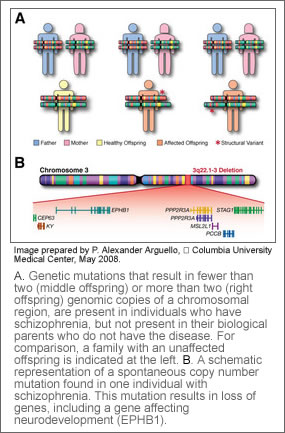 Watch this facinating series these time-lapse animations, compiled from brain scans taken over many years, neurologist Paul Thompson of the University of California, Los Angeles, describes brain maturation in children with and without schizophrenia. Move the slider beneath the image to see the changes over time.
Watch this facinating series these time-lapse animations, compiled from brain scans taken over many years, neurologist Paul Thompson of the University of California, Los Angeles, describes brain maturation in children with and without schizophrenia. Move the slider beneath the image to see the changes over time.
Read Benedict Carey’s article From the Elusiveness of Schizophrenia, New Clues to Treatment Published June 13, 2008 in the New York Times
The people who suffer from schizophrenia are hardly the only ones confounded by its symptoms. Scientists are baffled, too, and despite years of study they’ve had little success in explaining how the disorder develops, in whom, and why.
Yet there’s a restless energy among psychiatric researchers now, and it’s in part because of several recent studies that, paradoxically, reveal how insufficient current theories about schizophrenia are.
Source: New York Times
Â
 Scans of the genome of patients with schizophrenia have revealed rare spontaneous copy number mutations that account for at least 10 percent of the non-familial cases of the disease. Researchers at Columbia University Medical Center describe specific genetic mutations present in individuals who have schizophrenia, but not present in their biological parents who do not have the disease. These individuals were eight times more likely to have these mutations than unaffected individuals. This new data, reported in the May 30 on-line issue of Nature Genetics, will help researchers account for the persistence of schizophrenia in the population despite low birth rates among people with the disease.
Scans of the genome of patients with schizophrenia have revealed rare spontaneous copy number mutations that account for at least 10 percent of the non-familial cases of the disease. Researchers at Columbia University Medical Center describe specific genetic mutations present in individuals who have schizophrenia, but not present in their biological parents who do not have the disease. These individuals were eight times more likely to have these mutations than unaffected individuals. This new data, reported in the May 30 on-line issue of Nature Genetics, will help researchers account for the persistence of schizophrenia in the population despite low birth rates among people with the disease.
Researchers scanned the genome of 1,077 people which included 152 individuals with schizophrenia, 159 individuals without schizophrenia, and both of their biological parents for copy number mutations. They found mutations, either a gain or loss of genes, in 15 individuals diagnosed with schizophrenia that were not present in the chromosomes of either biological unaffected parent. Only two of such mutations were found in those without schizophrenia. Study subjects were from the European-origin Afrikaner population in South Africa, a genetically homogenous population that is ideal for genetic evaluation. [continue reading…]
Published: November 27, 2007
A theory that raises questions
Link to read this Washington Post article
Tuesday 27th November, 2007
By Shankar Vedantam [continue reading…]
Published: October 17, 2007
Major clues discovered in new research. Findings may lead to better medications to correct gene-related problem.
Results of the research were published in the October 17 issue of the Journal of Neuroscience, by Schahram Akbarian, MD, PhD, Hsien-Sung Huang, PhD student, and colleagues at the University of Massachusetts Medical School and Baylor College of Medicine. [continue reading…]
 Watch this facinating series these time-lapse animations, compiled from brain scans taken over many years, neurologist Paul Thompson of the University of California, Los Angeles, describes brain maturation in children with and without schizophrenia. Move the slider beneath the image to see the changes over time.
Watch this facinating series these time-lapse animations, compiled from brain scans taken over many years, neurologist Paul Thompson of the University of California, Los Angeles, describes brain maturation in children with and without schizophrenia. Move the slider beneath the image to see the changes over time.
